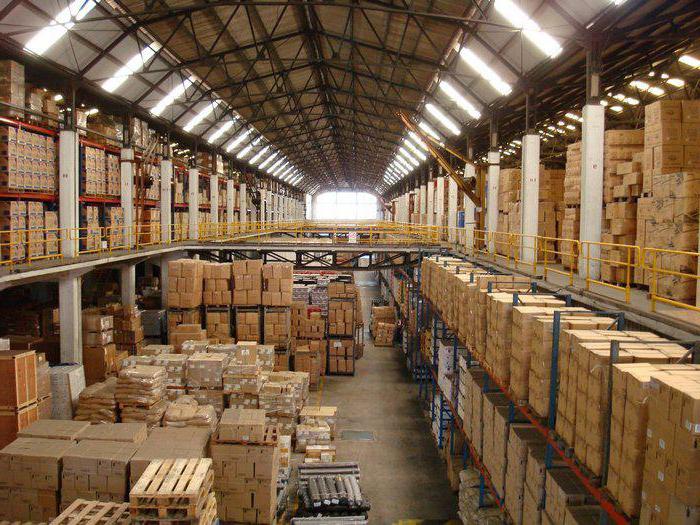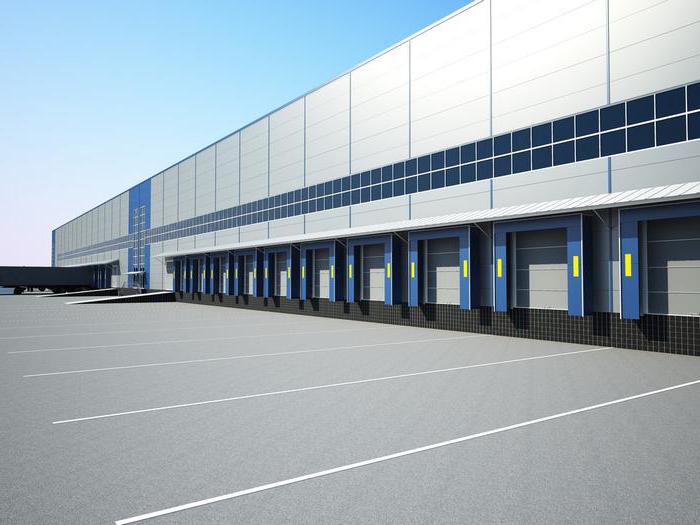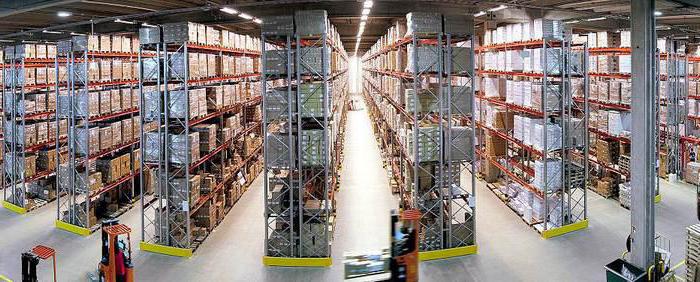Warehouses are intended for the reception, short-term storage and dispensing of semi-finished products, raw materials, and products delivered from suppliers. They can occupy separate areas, located in basements, on the first and ground floors. A key requirement for storage facilities is providing convenient communication with other main workshops. 
General information
The layout of the premises is carried out in the direction of movement of raw materials and products while ensuring the most convenient and most efficient execution of operations and loading and unloading activities. In large companies, combining several smaller firms, as a rule, there are central warehouses. From there, raw materials are sent to enterprises. Warehouses of this type can be used to store goods of one company or leased to legal entities and citizens under leasing conditions. Squares can also be workshop. Such warehouses serve specific departments of the enterprise in which they are located.
Complex operations
In any warehouse there are 3 types of material flows: internal, output and input. The presence of the latter means the need to unload transport, to check the quality and quantity of incoming raw materials or goods. The output stream involves loading or dispensing into production. Internal movement - the movement of materials and goods indoors. The complex of operations includes:
- Unloading.
- Acceptance
- Accommodation for storage.
- Transfer to destination.
- Internal displacement.
What are the requirements for storage facilities established by law?
For all areas used for the reception, placement and dispensing of raw materials and goods, special rules apply. Requirements for storage facilities ensure the safety of facilities, and are also aimed at protecting the health and life of the personnel of the enterprise, its property. First of all, norms are considered in the areas under consideration, the implementation of which prevents the occurrence of fire. Fire safety requirements for warehouses provide for special measures in accordance with which instructions are developed for each facility. When enrolling in a state or when transferring from one unit to another, each employee must familiarize themselves with them under signature.
Documentation
Fire safety requirements for warehouses include:
- In the instruction briefing.
- Guidance for action for employees in the event of fire.
- The procedure for working with combustible materials and substances and their disposal.
- Rules for interacting with oils and working with oiled workwear.
- Maximum allowable volumes and requirements for storage of fuel and lubricants.
- Schemes of sites designated for smoking and other places of using open fire.
- Rules for inspection of facilities, premises, power outages upon completion of work / shift.
Prominent places should include signs indicating security phones. 
Key Points
Regulatory acts establish the following fire requirements for storage facilities:
- Smoking within the specified areas is unacceptable.
- The places of unloading / loading, storage, dispensing and internal movement of raw materials and goods must undergo mandatory classification into fire and explosion safety categories.When installing electrical installations, zoning of sections is carried out.
- It is forbidden to place any objects within fire distances.
- The entry of locomotives into sections A, B, and C is prohibited.
- Admission of lifting equipment to hazardous materials is carried out in the presence and good condition of spark arrestors.
- Fire officers should be aware of the presence of flammable materials and substances in warehouses.
- Activities related to repetition, elimination of minor malfunctions, preparation of working mixtures are carried out in isolation from storage areas.
- Placement of any materials and substances is carried out taking into account their properties, fire hazardous features, the ability to combine the extinguishing agents used. Tires and rubber should be kept separate from other objects.
The fire requirements for storage facilities also include the duty of responsible persons to de-energize electrical equipment at the end of a shift / day. In storage places, there should be no emergency lighting, gas stoves, plug sockets, electric heaters.
Feed content
Storage should be carried out in extensions / outbuildings of farms that are separate from buildings. Basic requirements for storage facilities that contain roughage:
1. Partitions / ceilings / walls must be blind and made of non-combustible materials. Fire resistance - not less than 0.75 hours. Stacks / stacks, stacks and awnings are located at a distance:
- to power lines - more than 15 m;
- to roads - more than 20 m;
- to structures and buildings - more than 50 m.
2. Plots where stacks / stacks are placed are covered with a strip of 4 m wide around the entire perimeter. Its edge should be removed at a distance of not less than 15 m.
3. The area of the base of the stack may not exceed 500 m2, and for 1 stack / stack - 150 m2.
4. Fire distances are at least 20 meters. In the case of pairwise placement of stacks and awnings between them should be at least six, and between pairs - at least 30 meters.
5. The access of tractor tractors to stacks / stacks is carried out at a distance of at least 3 meters. In this case, the machines must be equipped with spark arresters.
6. Quarters of no more than 20 stacks / stacks should be located at a distance of one hundred meters from each other.
7. In case of high humidity, temperature control is required. 
Grain storage
Before harvesting, the content areas should be checked for operability and compliance with existing standards. The first requirement for storage facilities for grain storage concerns design features. Separate structures with gates opening outwards and not subject to clutter should be allocated for maintenance. During storage, the distance from the top of the embankment to electrical appliances should be more than 0.5 m. The requirements for the equipment of storage facilities for grain storage are as follows:
- It is not allowed to use mobile units with gates closed on both sides.
- It is forbidden to kindle dryers with flammable and combustible liquids, as well as using torches.
- In the process, friction of the belt and conveyor structures should be excluded.
- It is not allowed to carry out operations on dryers with faulty appliances.
- Fire chambers should be arranged so that the release of sparks is completely excluded. Spark suppressors are installed in the chimneys, and fire cutting is carried out in sections of their passage through combustible elements and structures.
- Mobile-type drying units are located at a distance of more than 10 m from the grain storage.
- Fans remove more than 2.5 m from walls that are made of combustible materials.
If the safety requirements for grain storage facilities are not met, the plots are considered unprepared. In the process of work it is necessary:
- Do not allow the filling of grain higher than the level of the tape.
- At least once every 2 hours during the drying period, you should check the temperature of the raw materials.
- Do not allow grain to be stored in one place with other equipment or materials.
- Clean the dryers daily.

Forest maintenance
The first requirement for storage facilities relates to their design. For storage of more than 10 thousand m3 Scaffolding uses the relevant technical standards for construction. To maintain a smaller volume of materials, plans for the installation of stacks are developed and agreed with the State Fire Supervision structures. The documentation indicates:
- The maximum amount of forest.
- Fire driveways and distances. These gaps should not be cluttered under any circumstances.
Another important requirement for storage facilities is the availability of an extinguishing plan. It clearly establishes the sequence of actions of personnel. Primary extinguishing media must be present at material storage areas. In addition, special posts should be equipped in accordance with the fire safety plan. Prefabricated electric heaters are used to heat utility areas. These premises should be in separate buildings. Winch sites must be cleaned of combustible waste and debris. They must be cleaned in special containers. Winches that work on the internal combustion engine must be located from stacks at a distance of more than 15 m. In closed warehouses:
- Partitions and office spaces are excluded.
- Passages opposite the doors - at least 1 m.
- Floors are made of non-combustible materials.
- The distance from the walls to the stacks is at least 0.8 m.
Peat and coal storage
Warehouses should be planned in such a way that they are not flooded with ground or flood waters in the spring season. Forbidden:
- To carry out coal unloading on old dumps lying more than a month.
- Take in storage raw materials with identified foci of self-ignition.
- Ship and transport burning peat and coal.
- Locate raw materials near electrical appliances and other heat sources.
Warehousing of various grades of peat and coal is carried out in separate stacks. In this case, the raw material is checked for the absence of foreign impurities that create a risk of ignition. Loading and unloading are carried out no more than two days. The same time is allocated for stacking peat and coal in stacks for long-term storage.
Systematic control temperature condition carried out by installing thermometers and iron pipes in the slopes. In case of fire, coal is removed from the stack. After that, it is stewed with water. When the temperature rises to more than 60 degrees, the stack is compacted in the corresponding foci. At the same time, reheating of the heated raw material is performed. Other safe methods of reducing the temperature are allowed. In case of fire of lumpy peat in stacks, the foci are thrown with a wet mass or poured with the addition of a wetting agent. The affected part is then disassembled. In case of ignition, milled peat must be removed. In place of the recess should be placed and rammed the wet mass. It is not allowed to return spontaneously burnt peat or coal to stacks after they are extinguished. 
Industrial storage facilities: SanPiN requirements
Storage of raw materials, goods, materials should be carried out in compliance with the norms established both for the facilities themselves and their places of detention, personnel, aggregates and devices, structures / buildings. Sanitary and epidemiological requirements for storage facilities are divided into 3 groups. Standards developed:
- For perfumes and cosmetics.
- Refrigerators.
- Food products.
Foodstuffs
Existing rules establish requirements:
- Organization of storage facilities. The rules govern, including the layout and arrangement of storage facilities.
- Sanitary condition.
- The content of food raw materials and goods. In particular, the requirements for shelving in warehouses are determined.
- To the conditions of storage of objects.
Food products that are taken to the warehouse must have supporting documents. They confirm the quality, origin and safety of the facilities. In addition to this product, they are tested for compliance with technical standards. Sanitary requirements for storage facilities include rules for storing frozen and perishable goods. Such products, in particular, are accepted for storage in an amount that corresponds to the volume of working refrigerators. Perishable goods, for which a more stringent regime is not provided, are contained at temperatures up to +6 degrees.
It is not allowed to overdo products from the supplier’s packaging. The container must be intact, dry, clean, free from odors. Labels and tags on the supplier’s packaging are retained until the expiration date of the products. Sanitary requirements for storage facilities establish rules for observing temperature, light regime and humidity in accordance with technical documentation. Performance monitoring is carried out daily using appropriate devices. They are installed in prominent areas, away from evaporators and doors. 
The rules of the commodity neighborhood
Technical regulations establish the following requirements for the storage facilities of alcoholic beverages and food products:
- Products with specific odors are kept separate from objects that absorb them.
- Joint storage of raw semi-finished and finished goods, benign and spoiled products is not allowed. Household materials, trolleys, containers and non-food items are kept separate from food products.
- Pallets, racks, shelves should be disinfected, easy to clean. They must be placed at a distance of not less than 15 cm from the floor.
- Storage of food products near sewage, water pipes, heating devices and outside the warehouse is not allowed. Unpackaged food items are not placed on the floor in bulk.
Separate hygiene requirements have also been developed for storage facilities for storing different types of food products. So, the content of meat, bread, fish has a number of nuances. In particular, these products cannot be stored in one warehouse.
Refrigerators
In distribution units, perishable products are processed, and chilled and frozen products are stored. Typically, refrigerators are used in catering and trade. In this regard, special hygiene requirements apply. Instructions developed for each type of goods, as well as regulatory and technical documents, apply to warehouses. All products, with the exception of chilled meat and cheeses without containers, are stacked in stable stacks tightly, without protrusions. A label of a special form is provided for each batch. It remains until the completion of the party. To verify the mass and quality of products, they are stamped "K".
These products are placed separately on pallets or piles with the side imprinted to the passage or passage. Control plots should be maintained until completion. The products are stacked on slats / pallets in stacks at a distance from the floor of at least 10-15 cm. Driveways must be installed. Their width is not less than 1.6 m, including the distance from walls, batteries and wall columns to the stack. The height of the stack is determined in accordance with the tare strength and the maximum permitted loads per 1 square. m of overlap and conditions for the maximum possible use of the internal height of the refrigerator.
It is not allowed to store products on the floor of the corridor, chamber or platform, or to drag along the floor. In the process of loading batches of products with different storage periods, those batches that have a shorter period are placed close to the place of unloading. To maintain objects of inadequate quality, a special camera or another separate room is allocated. In the process of product sales, quality is checked by specialists in standards and technical specifications. A certificate must be issued for each batch. The document must contain the physicochemical parameters of the goods and quality indicators. The sanitary condition of the cells, storage conditions of products is controlled in accordance with departmental technological instructions. 
Perfumes and cosmetics
In the process of accepting any consignment of materials, raw materials, reagents to the warehouse, the integrity of the labels and packaging, the availability of certificates should be checked. All products are registered. The consignments received are kept in special rooms, separated from the main production shops in compliance with the storage conditions for the goods for the established periods. At the same time, measures must be taken to prevent contamination and mixing of raw materials, materials and reagents, as well as providing ease of access. Rejected batches must be labeled to exclude their entry into production. Any packaging should ensure the safety of the properties of the products, the convenience of their use over the established periods of validity.
Conclusion
The capacity of any warehouse should correspond to the volume of the products that will be stored in it, as well as the principles of rational distribution of products. In addition, when planning, it is necessary to take into account the need for cleaning and other mandatory technical operations. Plots for receiving and placing products should be divided. Separate rooms are required to store flammable and toxic compounds. In the storage areas, the presence of unauthorized entities is not allowed without appropriate permission from the administration of the enterprise. The device of any warehouse should provide:
- Absolute qualitative and quantitative preservation of values.
- Appropriate conditions of detention.
- Rational sequence of operations.
- Normal working conditions.
The enterprises also envisage plots for the maintenance of containers, inventory, linen, etc. The equipment of warehouses depends on the capacity and type of production, and the standards for stocking goods. Equally important is the specifics of the enterprise. For catering and trade organizations, fairly stringent requirements are provided. This is due to the fact that such enterprises work with food products sold to the population. The control of the state of storage facilities is carried out by the responsible persons of the organization, appointed by order of the head, as well as representatives of authorized supervisory services.








